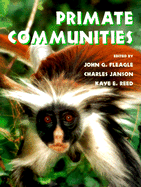Book contents
- Frontmatter
- Contents
- List of contributors
- Preface
- 1 African primate communities: Determinants of structure and threats to survival
- 2 Biomass and use of resources in south and south-east Asian primate communities
- 3 Species coexistence, distribution, and environmental determinants of neotropical primate richness: A community-level zoogeographic analysis
- 4 Primate communities: Madagascar
- 5 Primate diversity
- 6 Phylogenetic and temporal perspectives on primate ecology
- 7 Population density of primates in communities: Differences in community structure
- 8 Body mass, competition and the structure of primate communities
- 9 Convergence and divergence in primate social systems
- 10 Of mice and monkeys: Primates as predictors of mammal community richness
- 11 Comparing communities
- 12 Large-scale patterns of species richness and species range size in anthropoid primates
- 13 The recent evolutionary past of primate communities: Likely environmental impacts during the past three millennia
- 14 Resources and primate community structure
- 15 Effects of subsistence hunting and forest types on the structure of Amazonian primate communities
- 16 Spatial and temporal scales in primate community structure
- 17 Primate communities in Africa: The consequences of long-term evolution or the artifact of recent hunting?
- 18 The future of primate communities: A reflection of the present?
- 19 Concluding remarks
- Systematic index
- Subject index
1 - African primate communities: Determinants of structure and threats to survival
Published online by Cambridge University Press: 21 August 2009
- Frontmatter
- Contents
- List of contributors
- Preface
- 1 African primate communities: Determinants of structure and threats to survival
- 2 Biomass and use of resources in south and south-east Asian primate communities
- 3 Species coexistence, distribution, and environmental determinants of neotropical primate richness: A community-level zoogeographic analysis
- 4 Primate communities: Madagascar
- 5 Primate diversity
- 6 Phylogenetic and temporal perspectives on primate ecology
- 7 Population density of primates in communities: Differences in community structure
- 8 Body mass, competition and the structure of primate communities
- 9 Convergence and divergence in primate social systems
- 10 Of mice and monkeys: Primates as predictors of mammal community richness
- 11 Comparing communities
- 12 Large-scale patterns of species richness and species range size in anthropoid primates
- 13 The recent evolutionary past of primate communities: Likely environmental impacts during the past three millennia
- 14 Resources and primate community structure
- 15 Effects of subsistence hunting and forest types on the structure of Amazonian primate communities
- 16 Spatial and temporal scales in primate community structure
- 17 Primate communities in Africa: The consequences of long-term evolution or the artifact of recent hunting?
- 18 The future of primate communities: A reflection of the present?
- 19 Concluding remarks
- Systematic index
- Subject index
Summary
INTRODUCTION
Africa is an immense continent covering approximately 30 million km2 and encompassing 49 countries. For decades Africa has been considered a continent of great mystery, partly stemming from the fact that when Europeans first traveled to Africa, they found large expanses of seemingly impenetrable forests. Further, the first explorers often pressed inland by following rivers and thus often encountered only long stretches of riverine forest. In reality, the majority of the rainforest in Africa is situated in a belt that extends less than 10° north and south of the equator, and it is frequently broken by savanna or dry forest (e.g., the 300 km wide Dahomey Gap in West Africa). Thus, unlike the initial impressions of continuous homogenous forest, Africa actually contains a myriad of habitats from multistrata tropical forest, to dry deciduous forest, woodland, savanna, and desert. Along with the variety of habitats found within the continent, Africa harbors a great diversity of primate communities: at least 64 species of primates are found in Africa (15 prosimians, 46 monkeys, and 3 apes, Oates, 1996a; Fig. 1.1).
The objective of this chapter is to provide a template with which to begin to understand the diversity of primate communities in Africa's tropical forests. To do this, we first review the nature of the forested habitats in which primates occur, describing general habitat characteristics and, when possible, providing detailed contrasts of rainfall and forest structure.
- Type
- Chapter
- Information
- Primate Communities , pp. 1 - 37Publisher: Cambridge University PressPrint publication year: 1999
- 38
- Cited by



